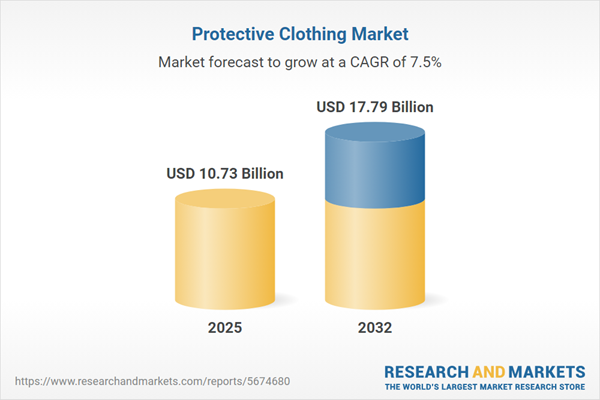Speak directly to the analyst to clarify any post sales queries you may have.
Senior executives in safety-critical sectors are facing an evolving protective clothing market shaped by regulatory shifts, technology innovation, and modern supply chain strategies. Adapting procurement and risk management is essential for maintaining operational reliability in changing global environments.
Market Snapshot: Protective Clothing Market Analysis
The global protective clothing market is valued at USD 9.97 billion, projected to reach USD 10.73 billion by 2025 and USD 17.79 billion by 2032. This reflects a compound annual growth rate (CAGR) of 7.50% over the forecast period.
Market expansion is driven by persistent efforts to reduce workplace hazards, incorporate advanced safety features, and address more rigorous regulatory requirements. Organizations are prioritizing investments in material innovation, procurement optimization, and effective global sourcing models. Compliance initiatives play a pivotal role, supporting operational stability and risk management. The synergy among textile advancements, procurement flexibility, and harmonized global standards underpins the sustained momentum of the protective clothing market.Scope & Segmentation: Protective Clothing Market Overview for Senior Executives
- Product Types: Chemical-resistant suits, high-visibility clothing, specialized medical wear, cut-resistant apparel, electrically insulated garments, and fire-resistant clothing address diverse requirements and distinct sector threats.
- End Users: Chemical processing, construction, defense, healthcare, manufacturing, mining, oil and gas, public safety, and transportation sectors require targeted protective solutions based on their operational challenges and compliance mandates.
- Material Types: Composite compounds, advanced textiles, polymers, metal components, and durable rubber enable high performance and extended longevity in demanding operational environments.
- Applications: Solutions focus on mitigating risks from chemical exposure, thermal hazards, mechanical threats, electrical risks, and visibility challenges, safeguarding personnel and assets across high-risk scenarios.
- Distribution Channels: Direct sales, distributor networks, e-commerce platforms, and retail outlets provide scalable procurement models for organizations with global operations and complex supply requirements.
- Regions: Adoption and regulatory frameworks vary across the Americas, Europe, Middle East & Africa, and Asia-Pacific, creating a need for adaptability in product specifications and supplier engagement strategies.
- Companies Profiled: DuPont, 3M, Honeywell, MSA Safety, Ansell Limited, Kimberly-Clark, Teijin Limited, Ten Cate, Lakeland Industries, and Alpha Pro Tech are recognized for driving technological advancements and maintaining reliable supply networks.
Key Takeaways for Senior Decision-Makers
- Textile innovation—such as nanofiber advancements and bioengineered materials—improves comfort and multi-hazard protection, enabling broader industrial application and user adoption.
- Greater harmonization of international safety regulations streamlines procurement and opens new markets for multinational organizations, simplifying compliance tracking.
- Emerging IoT-enabled garments and integrated sensors drive enhanced workplace safety through real-time environmental monitoring and employee protection.
- Eco-friendly materials and sustainable approaches are influencing procurement preferences and supplier selection to align with stricter environmental criteria and ESG goals.
- Procurement models are becoming more responsive, promoting supply chain flexibility and supporting ongoing business continuity during periods of global sourcing or policy uncertainty.
Tariff Impact and Supply Chain Response
Recent US tariff adjustments have prompted manufacturers to reassess supplier partnerships, deepen automation efforts, and enhance collaboration in production and logistics. These measures are designed to boost supply chain resilience, maintain access to international markets, and ensure stable operations amid ongoing policy changes.
Methodology & Data Sources
This protective clothing market analysis draws on peer-reviewed literature, in-depth regulatory assessments, and proprietary B2B data. It incorporates expert interviews, end-user surveys, and direct engagement with regulatory bodies to provide decision-focused, actionable insight for industry leaders.
Why This Report Matters
- Delivers executive clarity on trends, safety investments, and regulations shaping procurement and compliance strategies for protective clothing.
- Supports the adaptation of supply chain structures and sourcing approaches as standards evolve and supplier networks expand globally.
- Enables organizations to plan for industry shifts, align with evolving compliance frameworks, and mitigate operational risks for sustainable competitiveness.
Conclusion
Leaders investing in technology advancement, regulatory alignment, and robust supply chain practices will be positioned for secure and resilient operations as the protective clothing industry continues to transform.
Additional Product Information:
- Purchase of this report includes 1 year online access with quarterly updates.
- This report can be updated on request. Please contact our Customer Experience team using the Ask a Question widget on our website.
Table of Contents
3. Executive Summary
4. Market Overview
7. Cumulative Impact of Artificial Intelligence 2025
Companies Mentioned
The companies profiled in this Protective Clothing market report include:- DuPont de Nemours, Inc.
- 3M Company
- Honeywell International Inc.
- MSA Safety Incorporated
- Ansell Limited
- Kimberly-Clark Corporation
- Teijin Limited
- Koninklijke Ten Cate B.V.
- Lakeland Industries, Inc.
- Alpha Pro Tech, Ltd.
Table Information
| Report Attribute | Details |
|---|---|
| No. of Pages | 187 |
| Published | November 2025 |
| Forecast Period | 2025 - 2032 |
| Estimated Market Value ( USD | $ 10.73 Billion |
| Forecasted Market Value ( USD | $ 17.79 Billion |
| Compound Annual Growth Rate | 7.5% |
| Regions Covered | Global |
| No. of Companies Mentioned | 11 |









